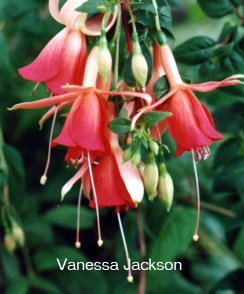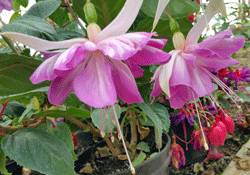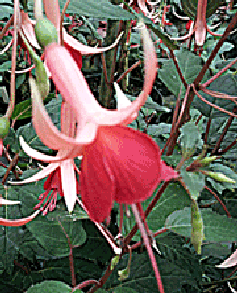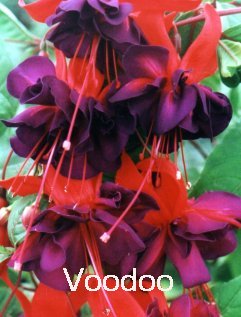|
|
U+V |
|
|
|
|
|
University of Liverpool. 1998 (D. Clark) Single. Tube and Sepals white. Corolla petals red. Vigorous compact trailing habit, very suitable for container growing, free flowering. |
|
|
|
|
Vanessa Jackson. 1980 (E. Handley). Single. Tube salmon-red. Sepals long salmon-orange. Corolla salmon-orange shading to orange-red, then cardinal-red at edges. Large trumpet shaped flowers, petal edges flared resembling a daffodil. Prolific flowering cascade fuchsia. |
|
|
|
|
Violet Bassett-Burr. 1972 (Holmes). Double. Tube short pink. Sepals very long veined pink to start on white base, green tipped. Corolla pale lilac, delightful shade. Excellent grower. Thoroughly recommended. Out of Stock |
|
|
|
|
Vivien Colville. 1980 (Dr. O. Colville). Single. Tube pink. Sepals orange upturned. Corolla starting deeper orange, red edged. Pistil very long, pink at top shading to orange. Flowers fine and petite, very freely produced, Strong upright growth, serrated leaf. |
|
|
|
|
Voodoo. 1952 (Tiret). Double. Tube and Sepals very dark red. Corolla dark purple-violet. Flowers large, free. Corolla full. Grows upright bush. Out of Stock |
|
|
|
PLEASE NOTE FOR WINTER MONTHS: H.1. requires greenhouse heated to minimum of 40°F (4.5°C). Although the above classifications are our recommendations, many of our customers are growing fuchsias that we classify as H.2 out of doors with good results and obviously with bigger blooms produced on H.2's than on The RHS and the British Fuchsia Society list many fuchsias that we classify as H2 medium hardy, as H3 hardy and with the climate changes (Global warming) this has probably become a fact |
|
|
|
A B C D E F G H I J K L M N O |
|||





